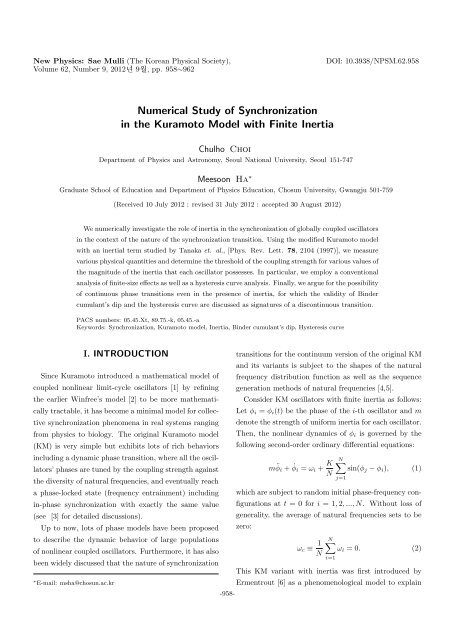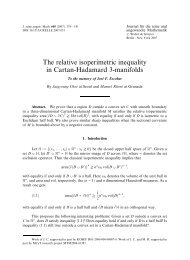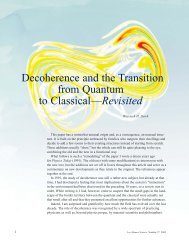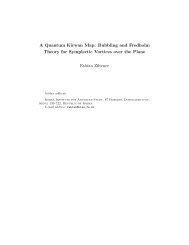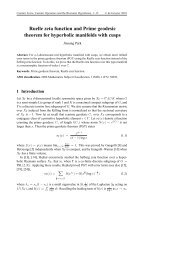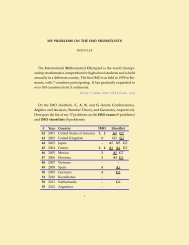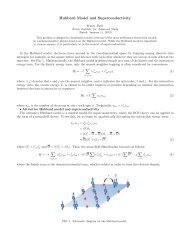Numerical Study of Synchronization in the Kuramoto Model ... - KIAS
Numerical Study of Synchronization in the Kuramoto Model ... - KIAS
Numerical Study of Synchronization in the Kuramoto Model ... - KIAS
Create successful ePaper yourself
Turn your PDF publications into a flip-book with our unique Google optimized e-Paper software.
New Physics: Sae Mulli (The Korean Physical Society),<br />
Volume 62, Number 9, 2012 9, pp. 958∼962<br />
DOI: 10.3938/NPSM.62.958<br />
<strong>Numerical</strong> <strong>Study</strong> <strong>of</strong> <strong>Synchronization</strong><br />
<strong>in</strong> <strong>the</strong> <strong>Kuramoto</strong> <strong>Model</strong> with F<strong>in</strong>ite Inertia<br />
Chulho Choi<br />
Department <strong>of</strong> Physics and Astronomy, Seoul National University, Seoul 151-747<br />
Meesoon Ha ∗<br />
Graduate School <strong>of</strong> Education and Department <strong>of</strong> Physics Education, Chosun University, Gwangju 501-759<br />
(Received 10 July 2012 : revised 31 July 2012 : accepted 30 August 2012)<br />
We numerically <strong>in</strong>vestigate <strong>the</strong> role <strong>of</strong> <strong>in</strong>ertia <strong>in</strong> <strong>the</strong> synchronization <strong>of</strong> globally coupled oscillators<br />
<strong>in</strong> <strong>the</strong> context <strong>of</strong> <strong>the</strong> nature <strong>of</strong> <strong>the</strong> synchronization transition. Us<strong>in</strong>g <strong>the</strong> modified <strong>Kuramoto</strong> model<br />
with an <strong>in</strong>ertial term studied by Tanaka et. al., [Phys. Rev. Lett. 78, 2104 (1997)], we measure<br />
various physical quantities and determ<strong>in</strong>e <strong>the</strong> threshold <strong>of</strong> <strong>the</strong> coupl<strong>in</strong>g strength for various values <strong>of</strong><br />
<strong>the</strong> magnitude <strong>of</strong> <strong>the</strong> <strong>in</strong>ertia that each oscillator possesses. In particular, we employ a conventional<br />
analysis <strong>of</strong> f<strong>in</strong>ite-size effects as well as a hysteresis curve analysis. F<strong>in</strong>ally, we argue for <strong>the</strong> possibility<br />
<strong>of</strong> cont<strong>in</strong>uous phase transitions even <strong>in</strong> <strong>the</strong> presence <strong>of</strong> <strong>in</strong>ertia, for which <strong>the</strong> validity <strong>of</strong> B<strong>in</strong>der<br />
cumulant’s dip and <strong>the</strong> hysteresis curve are discussed as signatures <strong>of</strong> a discont<strong>in</strong>uous transition.<br />
PACS numbers: 05.45.Xt, 89.75.-k, 05.45.-a<br />
Keywords: <strong>Synchronization</strong>, <strong>Kuramoto</strong> model, Inertia, B<strong>in</strong>der cumulant’s dip, Hysteresis curve<br />
I. INTRODUCTION<br />
S<strong>in</strong>ce <strong>Kuramoto</strong> <strong>in</strong>troduced a ma<strong>the</strong>matical model <strong>of</strong><br />
coupled nonl<strong>in</strong>ear limit-cycle oscillators [1] by ref<strong>in</strong><strong>in</strong>g<br />
<strong>the</strong> earlier W<strong>in</strong>free’s model [2] to be more ma<strong>the</strong>matically<br />
tractable, it has become a m<strong>in</strong>imal model for collective<br />
synchronization phenomena <strong>in</strong> real systems rang<strong>in</strong>g<br />
from physics to biology. The orig<strong>in</strong>al <strong>Kuramoto</strong> model<br />
(KM) is very simple but exhibits lots <strong>of</strong> rich behaviors<br />
<strong>in</strong>clud<strong>in</strong>g a dynamic phase transition, where all <strong>the</strong> oscillators’<br />
phases are tuned by <strong>the</strong> coupl<strong>in</strong>g strength aga<strong>in</strong>st<br />
<strong>the</strong> diversity <strong>of</strong> natural frequencies, and eventually reach<br />
a phase-locked state (frequency entra<strong>in</strong>ment) <strong>in</strong>clud<strong>in</strong>g<br />
<strong>in</strong>-phase synchronization with exactly <strong>the</strong> same value<br />
(see [3] for detailed discussions).<br />
Up to now, lots <strong>of</strong> phase models have been proposed<br />
to describe <strong>the</strong> dynamic behavior <strong>of</strong> large populations<br />
<strong>of</strong> nonl<strong>in</strong>ear coupled oscillators. Fur<strong>the</strong>rmore, it has also<br />
been widely discussed that <strong>the</strong> nature <strong>of</strong> synchronization<br />
transitions for <strong>the</strong> cont<strong>in</strong>uum version <strong>of</strong> <strong>the</strong> orig<strong>in</strong>al KM<br />
and its variants is subject to <strong>the</strong> shapes <strong>of</strong> <strong>the</strong> natural<br />
frequency distribution function as well as <strong>the</strong> sequence<br />
generation methods <strong>of</strong> natural frequencies [4,5].<br />
Consider KM oscillators with f<strong>in</strong>ite <strong>in</strong>ertia as follows:<br />
Let φ i = φ i (t) be <strong>the</strong> phase <strong>of</strong> <strong>the</strong> i-th oscillator and m<br />
denote <strong>the</strong> strength <strong>of</strong> uniform <strong>in</strong>ertia for each oscillator.<br />
Then, <strong>the</strong> nonl<strong>in</strong>ear dynamics <strong>of</strong> φ i is governed by <strong>the</strong><br />
follow<strong>in</strong>g second-order ord<strong>in</strong>ary differential equations:<br />
m ¨φ i + ˙φ i = ω i + K N<br />
N∑<br />
s<strong>in</strong>(φ j − φ i ), (1)<br />
∗ E-mail: msha@chosun.ac.kr<br />
Ermentrout [6] as a phenomenological model to expla<strong>in</strong><br />
-958-<br />
j=1<br />
which are subject to random <strong>in</strong>itial phase-frequency configurations<br />
at t = 0 for i = 1, 2, ..., N. Without loss <strong>of</strong><br />
generality, <strong>the</strong> average <strong>of</strong> natural frequencies sets to be<br />
zero:<br />
ω c ≡ 1 N∑<br />
ω i = 0. (2)<br />
N<br />
i=1<br />
This KM variant with <strong>in</strong>ertia was first <strong>in</strong>troduced by
<strong>Numerical</strong> <strong>Study</strong> <strong>of</strong> <strong>Synchronization</strong> <strong>in</strong> <strong>the</strong> <strong>Kuramoto</strong> <strong>Model</strong> with F<strong>in</strong>ite Inertia· · · – Chulho Choi · Meesoon Ha -959-<br />
Fig. 1. (Color onl<strong>in</strong>e) The order parameter r versus <strong>the</strong><br />
coupl<strong>in</strong>g strength K: m=1.0 (left) and m=0.1 (right),<br />
respectively, for various system sizes N with g L<br />
(ω)<br />
(Cauchy/Lorentzian) with ω o = 0 and d = 1. Even for<br />
m = 1.0, it seems no jump at a discont<strong>in</strong>uous transition.<br />
<strong>the</strong> slow synchronization <strong>of</strong> certa<strong>in</strong> biological systems,<br />
e.g., fireflies <strong>of</strong> <strong>the</strong> Pteroptyx malaccae, and later on, it<br />
has been used to describe various nonl<strong>in</strong>early coupled<br />
dynamical systems [7]. Equation (1) can be <strong>in</strong>terpreted<br />
as some mechanical analog <strong>in</strong> <strong>the</strong> context <strong>of</strong> <strong>the</strong> equation<br />
<strong>of</strong> motion: m ¨φ i (<strong>in</strong>ertia), ˙ φ i (damp<strong>in</strong>g) and ω i (driv<strong>in</strong>g<br />
torque), respectively.<br />
In this report, we numerically <strong>in</strong>vestigate <strong>the</strong> relevance<br />
<strong>of</strong> <strong>in</strong>ertia <strong>in</strong> synchronization <strong>in</strong> <strong>the</strong> context <strong>of</strong> <strong>the</strong> issue<br />
addressed by Tanaka and coworkers [8] that <strong>the</strong> modified<br />
KM with f<strong>in</strong>ite <strong>in</strong>ertia exhibits a first-order (discont<strong>in</strong>uous)<br />
phase transition based on discont<strong>in</strong>uous jumps and<br />
hysteresis curves <strong>of</strong> <strong>the</strong> order parameter, <strong>in</strong> contrast to a<br />
second-order (cont<strong>in</strong>uous) phase transition found <strong>in</strong> <strong>the</strong><br />
orig<strong>in</strong>al KM. We here test <strong>the</strong> conventional analysis <strong>of</strong><br />
f<strong>in</strong>ite-size effects as m → 0 besides <strong>the</strong> hysteresis analysis<br />
<strong>of</strong> <strong>the</strong> order parameter.<br />
Fig. 2. (Color onl<strong>in</strong>e) The susceptibility χ (1)<br />
2 versus K,<br />
where we use <strong>the</strong> same setup as Fig. 1, where <strong>the</strong> peak<br />
<strong>of</strong> χ (1)<br />
2 <strong>in</strong>dicates <strong>the</strong> location/neighborhood <strong>of</strong> synchronization<br />
threshold.<br />
Based on various properties <strong>of</strong> <strong>the</strong> order parameter, we<br />
propose comprehensive criteria <strong>in</strong> determ<strong>in</strong><strong>in</strong>g <strong>the</strong> nature<br />
<strong>of</strong> phase transitions with ei<strong>the</strong>r <strong>the</strong> dips or <strong>the</strong> cross<strong>in</strong>gs<br />
<strong>of</strong> <strong>the</strong> B<strong>in</strong>der cumulant (BC) near <strong>the</strong> threshold <strong>of</strong> <strong>the</strong><br />
coupl<strong>in</strong>g strength for various system sizes <strong>in</strong> <strong>the</strong> presence<br />
<strong>of</strong> different measurements due to anomalous sample-tosample<br />
fluctuations. This is attributed to <strong>the</strong> quenched<br />
disorder average <strong>of</strong> natural frequencies, first discussed<br />
by Hong and coworkers <strong>in</strong> <strong>the</strong> orig<strong>in</strong>al KM [9] without<br />
<strong>in</strong>ertia. Our BC analysis with f<strong>in</strong>ite <strong>in</strong>ertia are compared<br />
to <strong>the</strong> hysteresis curve analysis [8].<br />
This paper is organized after <strong>in</strong>troduction as follows:<br />
In Sec. II, basic physical quantities are briefly reviewed<br />
and numerically measured for <strong>the</strong> given distribution <strong>of</strong><br />
natural frequencies. Based on <strong>the</strong> conventional analysis<br />
<strong>of</strong> f<strong>in</strong>ite-size effects and <strong>the</strong> BC analaysis, we argue <strong>the</strong><br />
nature <strong>of</strong> <strong>the</strong> synchronization transition <strong>in</strong> <strong>the</strong> modified<br />
KM with f<strong>in</strong>ite <strong>in</strong>ertia. F<strong>in</strong>ally, some possible scenarios<br />
are summarized <strong>in</strong> Sec. III with open questions.
-960- “”, Volume 62, Number 9, 2012 9<br />
Fig. 3. (Color onl<strong>in</strong>e) The B<strong>in</strong>der’s cumulant (BC) U (1)<br />
4 versus K (<strong>the</strong> upper plots), and <strong>the</strong> probability distribution<br />
function (pdf) <strong>of</strong> r versus K (<strong>the</strong> lower plots) with <strong>the</strong> same setup as Fig. 1. While <strong>the</strong> BC dips become narrow and<br />
deep as N <strong>in</strong>creases with <strong>the</strong> clear two-peak pdfs for m = 1.0, <strong>the</strong>y are relatively wide and shallow with <strong>the</strong> unclear<br />
two-peak pdfs for m = 0.1. This implies two possible scenarios, <strong>the</strong> limitation <strong>of</strong> f<strong>in</strong>ite size systems and <strong>the</strong> evidence<br />
<strong>of</strong> cont<strong>in</strong>uous phase transitions for <strong>the</strong> small values <strong>of</strong> m, respectively.<br />
II. NUMERICAL RESULTS<br />
In order to speculate various physical properties <strong>of</strong><br />
synchronization, we perform <strong>the</strong> numerical <strong>in</strong>tegrations<br />
<strong>of</strong> Eq. (1) by Heun’s method, so-called <strong>the</strong> second order<br />
<strong>of</strong> <strong>the</strong> Runge-Kutta (RK2) method with two stages [10].<br />
Without loss <strong>of</strong> generality, <strong>the</strong> time step dt = 0.05 and<br />
at least 100 different samples are tested.<br />
The order parameter <strong>of</strong> synchronization is def<strong>in</strong>ed as<br />
r(t)e iθ(t) ≡ 1 N<br />
N∑<br />
e iφj(t) . (3)<br />
j=1<br />
Here we can consider two-types <strong>of</strong> sampl<strong>in</strong>g average,<br />
namely <strong>the</strong> disorder average, [...], over natural frequency<br />
sequences and <strong>in</strong>itial configurations, and <strong>the</strong> temporal<br />
average, 〈...〉, over some period after <strong>the</strong> system reaches<br />
<strong>the</strong> steady state. While <strong>in</strong> <strong>the</strong> steady-state regime <strong>the</strong><br />
order parameter r yields <strong>the</strong> same result, regardless <strong>of</strong><br />
<strong>the</strong> order <strong>of</strong> data collections, e.g., [〈r〉] = 〈[r]〉, o<strong>the</strong>r<br />
physical quantities can yield different results depend<strong>in</strong>g<br />
on <strong>the</strong> def<strong>in</strong>itions, e.g, susceptibility, χ (1)<br />
2 ≠ χ (2)<br />
2 , and<br />
BC, U (1)<br />
4 ≠ U (2)<br />
4 .<br />
χ (1) ≡ N[〈r 2 〉 − 〈r〉 2 ]; χ (2) ≡ N([〈r 2 〉] − [〈r〉] 2 ). (4)<br />
It is well-known that <strong>the</strong> distribution function shape <strong>of</strong><br />
natural frequencies determ<strong>in</strong>es <strong>the</strong> transition threshold<br />
<strong>of</strong> <strong>the</strong> coupl<strong>in</strong>g strength and <strong>the</strong> transition nature. So we<br />
specifically choose <strong>the</strong> s<strong>in</strong>gle-peak distribution function<br />
that exhibits a cont<strong>in</strong>uous transition <strong>in</strong> <strong>the</strong> orig<strong>in</strong>al KM<br />
<strong>in</strong> order to focus on <strong>the</strong> relevance <strong>of</strong> <strong>in</strong>ertia <strong>in</strong> <strong>the</strong> nature<br />
<strong>of</strong> synchronization transitions.<br />
We consider two cases <strong>of</strong> g(ω), <strong>the</strong> Gaussian and<br />
Cauchy (Lorentzian):<br />
g G<br />
(ω) =<br />
1<br />
√<br />
2πσ<br />
2 exp− (ω−ω 0 )2<br />
2σ 2 ; g L<br />
(ω) = 1 π [ d<br />
(ω − ω 0 ) 2 + d 2 ].
<strong>Numerical</strong> <strong>Study</strong> <strong>of</strong> <strong>Synchronization</strong> <strong>in</strong> <strong>the</strong> <strong>Kuramoto</strong> <strong>Model</strong> with F<strong>in</strong>ite Inertia· · · – Chulho Choi · Meesoon Ha -961-<br />
Fig. 4. (Color onl<strong>in</strong>e) The BC U (2)<br />
4 versus K, where <strong>the</strong><br />
same setup is used as Fig. 1. In contrast to Fig. 3, no<br />
dips exist. Instead, <strong>the</strong>re are <strong>the</strong> well-known BC cross<strong>in</strong>gs.<br />
However, <strong>the</strong>ir existence doesn’t mean a cont<strong>in</strong>uous<br />
transition.<br />
Fig. 5. (Color onl<strong>in</strong>e) Hysteresis curves <strong>of</strong> r as K <strong>in</strong>creases<br />
(forward, FW) from r(0) = 0 and decreases from<br />
r(0) ≃ 1 (backward, BW) for N = 500 with <strong>the</strong> same<br />
setup as Fig. 1.<br />
S<strong>in</strong>ce both functions are characterized by uncorrelated<br />
natural frequencies between two oscillators and <strong>the</strong> f<strong>in</strong>ite<br />
mean, ω o , so K c = 2<br />
πg(ω 0) , <strong>the</strong> data for <strong>the</strong> case <strong>of</strong> g L (ω)<br />
are only presented here.<br />
Once <strong>the</strong> distribution function <strong>of</strong> natural frequencies,<br />
g(ω), is chosen, <strong>the</strong> next step is how to generate <strong>the</strong> sequence,<br />
{ω i }, for f<strong>in</strong>ite-size (N-oscillator) systems, where<br />
i = 1, 2, ..., N. One can generate it ei<strong>the</strong>r stochastically<br />
(noisy) or determ<strong>in</strong>istically (noiseless), but <strong>the</strong> generation<br />
method <strong>of</strong> {ω i } is directly related to <strong>the</strong> FSS exponent<br />
and <strong>the</strong> dynamic exponent as reported <strong>in</strong> [4,11].<br />
Moreover, natural frequencies play a role <strong>of</strong> <strong>the</strong> quenched<br />
disorder <strong>in</strong> synchronization, <strong>the</strong> def<strong>in</strong>ition <strong>of</strong> U 4 should<br />
be also carefully discussed as po<strong>in</strong>ted out <strong>in</strong> [9].<br />
U (1)<br />
4 ≡ 1 − [〈r4 〉]<br />
3[〈r 2 〉] 2 ; U (2) 〈r 4 〉<br />
4 ≡ 1 − [<br />
3〈r 2 ]. (5)<br />
〉<br />
2<br />
In <strong>the</strong> presence <strong>of</strong> such a disorder, it is important<br />
to check <strong>the</strong> sample-to-sample fluctuations <strong>of</strong> physical<br />
quantities, def<strong>in</strong>ed as A O ≡ [2 ]<br />
[]<br />
− 1, where O is any<br />
2<br />
observable physical quantity, e.g., r or r 2 . A O is positive<br />
def<strong>in</strong>ite, which is supposed to vanish as N → ∞<br />
if <strong>the</strong> system is self-averag<strong>in</strong>g; to rema<strong>in</strong>s f<strong>in</strong>ite if not.<br />
For <strong>the</strong> orig<strong>in</strong>al <strong>Kuramoto</strong> model, it has been already<br />
reported by Hong and coworkers [9] that A r 2<br />
saturates<br />
to a f<strong>in</strong>ite value at criticality due to <strong>the</strong> relevance <strong>of</strong> <strong>the</strong><br />
quenched randomness <strong>in</strong> natural frequencies. We have<br />
observed <strong>the</strong> similar behavior <strong>of</strong> A O <strong>in</strong> <strong>the</strong> <strong>the</strong> modified<br />
<strong>Kuramoto</strong> model with f<strong>in</strong>ite <strong>in</strong>ertia.<br />
As shown <strong>in</strong> Figs. 1-5 and stated <strong>in</strong> <strong>the</strong> captions, numerical<br />
results for m = 1.0 and m = 0.1 are quite similar<br />
<strong>in</strong> some aspects, but those are quite different <strong>in</strong> o<strong>the</strong>r<br />
aspects. However, with <strong>the</strong> current resolution <strong>of</strong> our numerical<br />
data, it is not clear to conclude how <strong>the</strong> BC dips<br />
and cross<strong>in</strong>gs at <strong>the</strong> transition threshold are developed <strong>in</strong><br />
<strong>the</strong> <strong>the</strong>rmodynamic limit as well as <strong>the</strong> hysteresis curve<br />
<strong>of</strong> r for <strong>the</strong> small value <strong>of</strong> m. In o<strong>the</strong>r words, we need
-962- “”, Volume 62, Number 9, 2012 9<br />
more careful and systematic techniques to analyze f<strong>in</strong>ite<br />
numerical data obta<strong>in</strong>ed from various setup conditions<br />
<strong>in</strong> <strong>the</strong> context <strong>of</strong> f<strong>in</strong>ite-size scal<strong>in</strong>g and dynamic scal<strong>in</strong>g.<br />
III. SUMMARY AND REMARK<br />
In summary, <strong>the</strong> relevance <strong>of</strong> <strong>in</strong>ertia <strong>in</strong> synchronization<br />
has been numerically revisited <strong>in</strong> terms <strong>of</strong> <strong>the</strong> modified<br />
<strong>Kuramoto</strong> model with <strong>in</strong>ertia as compared to <strong>the</strong> ord<strong>in</strong>ary<br />
one us<strong>in</strong>g <strong>the</strong> conventional analysis <strong>of</strong> f<strong>in</strong>ite-size effects<br />
<strong>in</strong> <strong>the</strong> steady-state limit. Our results impose that it<br />
is quite difficult how to clarify <strong>the</strong> nature <strong>of</strong> synchronization<br />
<strong>in</strong> <strong>the</strong> presence <strong>of</strong> <strong>in</strong>ertia even though some criteria<br />
<strong>of</strong> <strong>the</strong> discont<strong>in</strong>uous (first-order) phase transition seem<br />
exist, such as non-vanish<strong>in</strong>g dips <strong>in</strong> some specific def<strong>in</strong>ition<br />
<strong>of</strong> BC and hysteresis curves and non-vanish<strong>in</strong>g areas<br />
<strong>in</strong> <strong>the</strong> <strong>the</strong>rmodynamic limit.<br />
F<strong>in</strong>ally, we have been aware <strong>of</strong> very slow relaxation <strong>in</strong><br />
<strong>the</strong> presence <strong>of</strong> <strong>in</strong>ertia and <strong>the</strong> setup-dependent scal<strong>in</strong>g<br />
properties through this work. Hence, it is quite crucial<br />
to check out if <strong>the</strong> system reaches its true steady state<br />
before discuss<strong>in</strong>g <strong>the</strong> ma<strong>in</strong> issue <strong>of</strong> <strong>the</strong> transition nature.<br />
The dynamic behavior <strong>of</strong> synchronization near and at<br />
<strong>the</strong> synchronization transition <strong>in</strong> <strong>the</strong> modified <strong>Kuramoto</strong><br />
model is under <strong>in</strong>vestigation [11] as compared with <strong>the</strong><br />
orig<strong>in</strong>al one.<br />
ACKNOWLEDGEMENTS<br />
This work is supported by <strong>the</strong> National Research<br />
Foundation <strong>of</strong> Korea (NRF) grant funded by <strong>the</strong> Korean<br />
Government (MEST) (No. 2011-0011550).<br />
REFERENCES<br />
[1] Y. <strong>Kuramoto</strong>, <strong>in</strong> Proceed<strong>in</strong>gs <strong>of</strong> <strong>the</strong> International<br />
Symposium on Ma<strong>the</strong>matical Problems <strong>in</strong> Theoretical<br />
Physics, edited by H. Araki (Spr<strong>in</strong>ger-Verlag,<br />
New York, 1975); Y. <strong>Kuramoto</strong>, Chemical Oscillations,<br />
Waves and Turbulence (Spr<strong>in</strong>ger-Verlag,<br />
Berl<strong>in</strong>, 1984); Y. <strong>Kuramoto</strong> and I. Nishikawa, J.<br />
Stat. Phys. 49, 569 (1987).<br />
[2] A. T. W<strong>in</strong>free, J. Theor. Biol. 16, 15 (1967); The<br />
Geometry <strong>of</strong> Biological Time (Spr<strong>in</strong>ger, New York,<br />
1980).<br />
[3] J. A. Acebrón et. al., Rev. Mod. Phys. 77<br />
135 (2005); B. C. Daniels, Available at http://go.<br />
owu.edu/physics/StudentResearch/2005/BryanDan<br />
iels/<strong>Kuramoto</strong>-paper.pdf, 2005.<br />
[4] H. Hong, H. Park, M. Y. Choi, Phys. Rev. E<br />
70, 045204(R) (2005); ibid. 72, 036217 (2005); H.<br />
Hong et. al., Phys. Rev. Lett. 99, 184101 (2007);<br />
H. Hong, H. Park and L.-H. Tang, Phys. Rev. E<br />
76, 06610 (2007); S.-W. Son and H. Hong, ibid.,<br />
81, 061125 (2010); L.-H. Tang, J. Stat. Mech.<br />
(2011) P01034.<br />
[5] D. Pazó, Phys. Rev. E 72, 04611 (2005).<br />
[6] G. B. Ermentrout, J. Math. Biol. 29, 571 (1991).<br />
[7] J. A. Acebrón and R. Spigler, Phys. Rev. Lett. 81,<br />
2229 (1998); B. C. Daniels, S. T. Dissanayake and<br />
B. R. Trees, Phys. Rev. E. 67, 026216 (2003); K.<br />
Park and M. Y. Choi, Phys. Rev. B 56, 387 (1997);<br />
K. Wiesenfeld, R. Colet and S. H. Strogatz, Phys.<br />
Rev. E 57, 1563 (1988); ibid., Phys. Rev. Lett. 76,<br />
404 (1996); S. Watanabe and J. W. Swift, J. Nonl<strong>in</strong>ear<br />
Sci. 7, 503 (1997); S. Watanabe and S. H.<br />
Strogatz, Physica D 74, 197 (1994); K. Wiesenfeld<br />
and J. W. Swift, Phys. Rev. E 51, 1020 (1995).<br />
[8] H.-A. Tanaka, A. J. Lichtenberg and S. Oishi, Phys.<br />
Rev. Lett. 78, 2104 (1995).<br />
[9] H. Hong, H. Park, L.-H. Tang, J. Kor. Phys. Soc.,<br />
45, L1885 (2006).<br />
[10] R. L. Burden and J. D. Faires, <strong>Numerical</strong> Analysis<br />
(Brooks/Cole, Pacific Grove, 1997) p.280;<br />
Wikipedia, “Runge-Kutta methods”, http://en.<br />
wikipedia.org/wiki/Runge-Kutta methods.<br />
[11] C. Choi, M. Ha and B. Kahng (<strong>in</strong> preparation).


